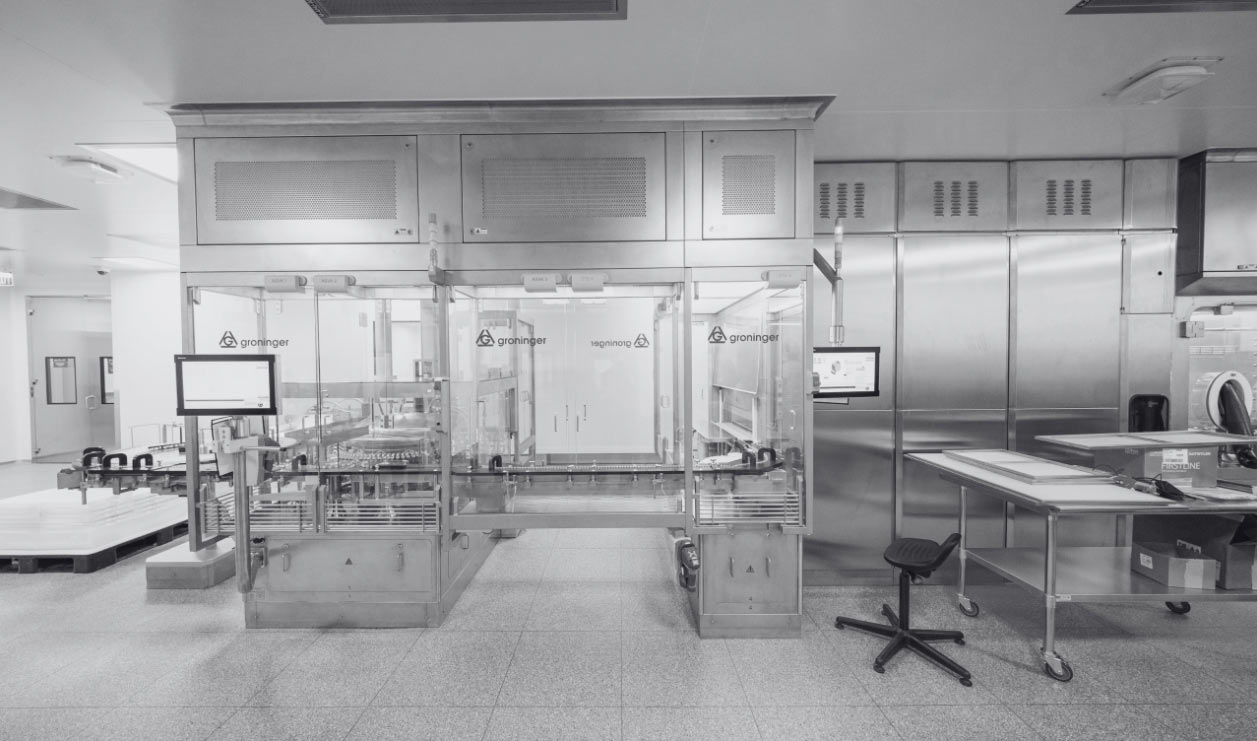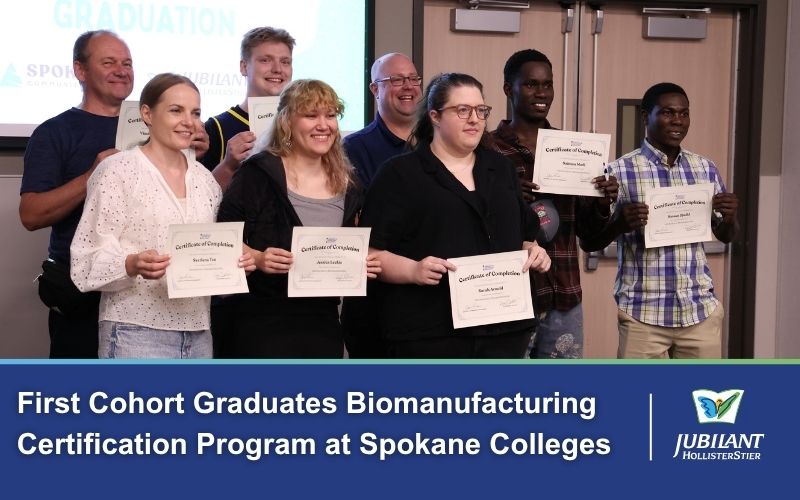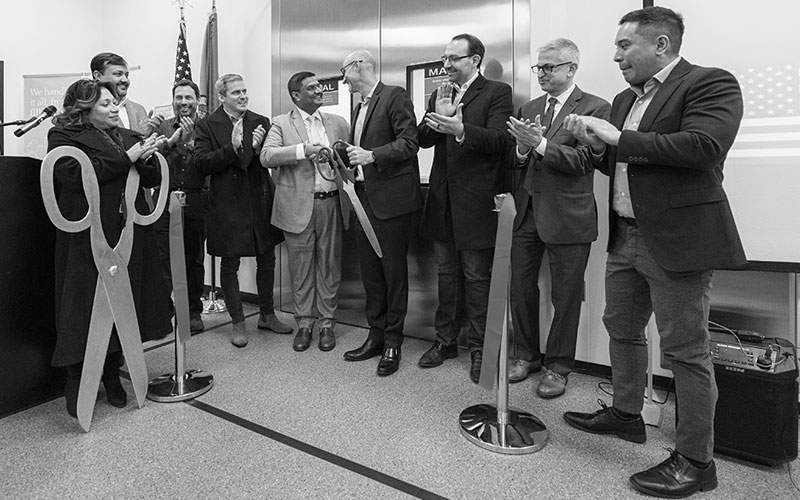
A Step-by-Step Breakdown
- Preparation and Sterilization of Components: All components, including vials, stoppers, and caps, undergo rigorous cleaning and sterilization processes to eliminate any potential contaminants.
- Aseptic Filling Process: The sterile drug product is filled into the prepared containers using highly controlled environments and advanced filling machines to maintain sterility.
- Capping and Sealing: Once filled, containers are immediately sealed to prevent any contamination of the biologic product so that the product remains sterile until administration to the patient.
- Visual Inspection and Quality Control: Each filled container undergoes a thorough visual inspection to detect any defects or particulate matter to guarantee future patient safety. After this, the product/container undergoes various quality control tests to verify sterility and product integrity.
- Labeling and Final Packaging: Finally, the containers are labeled with essential information and packaged according to the regulatory requirements so that they are ready for distribution.
Technologies and Equipment Used
The sterile fill finish process relies on state-of-the-art technologies and equipment to ensure an effective, safe product for the consumer:
- Isolators and Restricted Access Barrier Systems (RABS): These systems provide a controlled environment, minimizing the risk of contamination during the filling process. Jubilant HollisterStier utilizes isolator technology in our third sterile fill finish manufacturing line and is currently adding an additional isolator line in our future expansion.
- Automated Filling Machines: Highly precise and automated filling machines guarantee accurate and consistent filling while reducing human error and contamination.
- Cleanrooms and Controlled Environments: These specially designed envrionments maintain strict control over particulate matter, potential human contamination, temperature, and humidity, which is crucial to the aseptic filling process.
Regulatory Compliance and Standards
Overview of Regulatory Requirements
Adhering to regulatory standards is an important aspect of successful sterile fill finishing manufacturing. CMOs typically adhere to multiple regulatory guidelines maintained and provided by regulatory agencies such as the U.S. Food and Drug Administration (FDA), European Medicines Agency (EMA), and more. Jubilant HollisterStier maintains regulatory compliance with eleven regulatory agencies, including the FDA and EMA, along with Health Canada, ANVISA, MAH Turkey, MOH Russia, TGA, PMDA, MFDS, MHRA, and the Kenya Health Authority.
There are several key guidelines and standards that are a part of the regulatory compliance requirements found throughout these different agencies:
- Current Good Manufacturing Practices (cGMP): These are the regulations that are enforced by the regulatory agency so that every product is consistent and controlled according to universal quality standards. cGMP covers all aspects of production, from raw materials to final product.
- Agency Specific Guidelines: Each agency provides guidelines outside of the general cGMP required for sterile drug products produced by aseptic processing within their own country of origin.
- International Organization for Standardization (ISO) Standards: ISO standards specify requirements for quality management systems used for the design of sterile products are ultilized in every CMO.
Quality Assurance and Control
Quality assurance and control measures are an essential aspect when it comes to the sterility and quality of pharmaceutical products. Some of these processes include:
- Sterility Testing: Comprehensive testing that confirms the absence of viable microorganisms in the product that could potentially affect patients in the future and the quality of the product.
- Endotoxin Testing: This test detects whether there are bacterial endotoxins that could cause adverse reactions in patients and make the product not viable.
- Environmental Monitoring: Continuous monitoring of the production environment is used to detect any potential contamination sources and guarantees that the facility complies with cleanliness standards.
Benefits of Outsourcing Sterile Fill Finish Manufacturing

Outsourcing sterile fill finish manufacturing operations to specialized CMOs such as Jubilant HollisterStier offers several advantages for pharmaceutical companies:
- Cost Savings: Outsourcing reduces the need for significant capital investment in specialized facilities and equipment, leading to considerable cost savings. Additionally, it lowers operational costs by leveraging the economies of scale achieved by CMOs.
- Access to Expertise: CMOs that specialize in sterile fill finish processes bring extensive experience and technical knowledge when managing a manufacturing project. This expertise ensures high-quality outcomes and compliance with stringent regulatory standards.
- Flexibility and Scalability: Outsourcing provides the flexibility to scale production up or down based on market demand. This scalability allows pharmaceutical companies to respond quickly to changes in product demand without the constraints of fixed capacity.
- Focus on Core Competencies: When outsourcing to a CMO, pharmaceutical companies can concentrate on their core competencies, such as research and development, while leaving the complex manufacturing processes to the experts with the right resources.
Challenges and Considerations
While outsourcing sterile fill finish manufacturing offers numerous benefits, there are also challenges and considerations to keep in mind while searching for the right CMO partner. Some of these considerations include:
- Quality Assurance: Maintaining consistent quality and sterility is paramount when manufacturing an efficacious product. When deciding on a CMO partner, ensuring that they adhere to the highest standards of quality control and assurance is critical to produce a safe product for patients.
- Supply Chain Management: Effective supply chain management is crucial when it comes to the timely delivery and availability of raw materials and components. Any disruptions can impact production schedules and product availability. Finding a CMO that has a successful supply chain and efficient management could make or break a successful partnership.
- Risk Management: Identifying and mitigating risks associated with outsourcing is essential. This includes evaluating the CMO’s contingency plans for supply chain disruptions and their ability to maintain production continuity under adverse conditions. An additional way to minimize risk is to have multiple lines, and even facilities, available for manufacturing. Currently, JHS has four operational sterile liquid fill lines across two facilities so that each client can be certain their project will be completed on deadline.
Sterile fill finish contract manufacturing plays a major role in the pharmaceutical industry, ensuring the sterility and safety of products critical to patient safety. By outsourcing these complex processes to specialized CMOs, pharmaceutical companies can leverage cost savings, access to expertise, flexibility and scalability, while focusing on their core competencies.
Selecting the right CMO involves careful consideration of their experience, technological capabilities, regulatory compliance history, and capacity. Successful partnerships demonstrate the value of collaboration and importance of choosing a reliable CMO.
As the industry continues to evolve, innovations and technological advancements will drive further improvements in sterile fill finish processes, making them more efficient, reliable, and capable of meeting the growing demands of the biopharmaceutical sector.
Reach out to the Jubilant HollisterStier team today to learn how we support our partners in seeing the full potential of their sterile fill finish manufacturing projects and how we are embracing the future through our current expansion projects.
Article References
- “Fill-Finish Pharmaceutical Contract Manufacturing Market.” Www.grandviewresearch.com, www.grandviewresearch.com/industry-analysis/fill-finish-pharmaceutical-contract-manufacturing-market-report. Accessed 11 July 2024.



